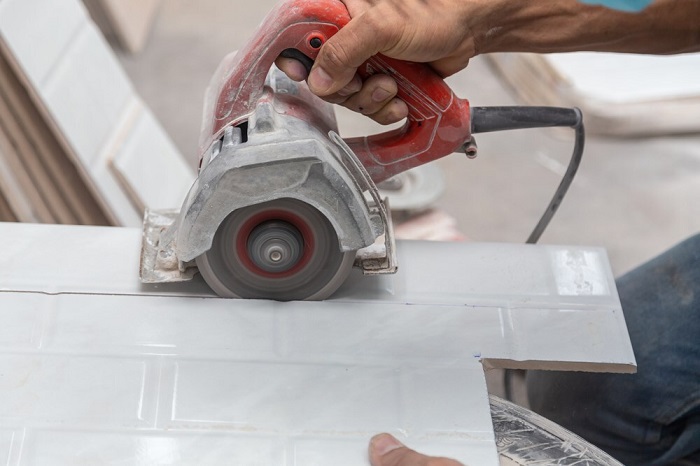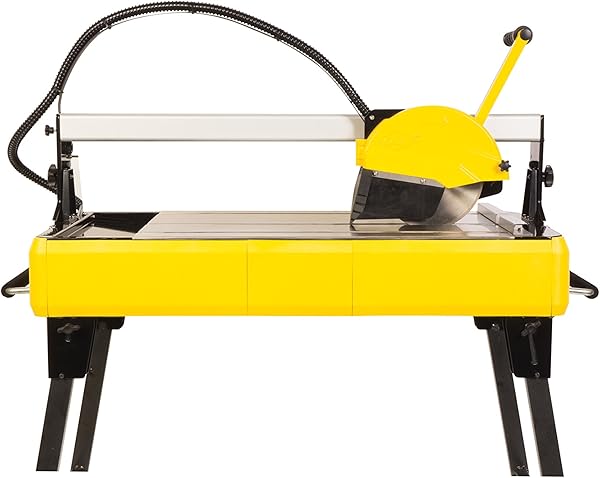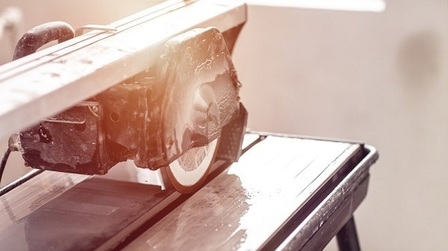If you’re looking to cut tile, you need to understand the various types of tile saws you can use. Popular options include wet tile saws, dry tile saws and handheld tile saws.
These types of tile saws are made for easier cuts. They don’t require as much force as traditional tile cutters. Apart from being easier to use, they’re also associated with the following benefits.
Smooth Cuts
A good tile saw is made with a smooth tray. It holds the tile in place for more precise cuts. If you’re planning of cutting multiple pieces of tile to the exact measurements, a fence holds the pieces of tile in places for added precision.

Easy Miter Cuts
Miter cuts are normally possible with the best tile saws up to 45-degrees. These cuts are a bit more technical but a good blade on a tile saw is going to do the job with high precision.
Plunge Cuts
Plunge cuts are made to high precision with a tile saw. These types of cuts are particularly useful on the thicker tile.
Types of Tile Saws – How To Buy The One You Need?
Not everybody cutting tile is a contractor. You might be looking to cut tile at home. This is why you need to choose the type of tile saw you need.
If you want to buy a tile saw, here are a few popular variations of the tile saw with their strengths and weaknesses.
Handheld Tile Saw
You hold these practical saws by hand, as their name suggests. As you have total freedom of movement, these saws are used for irregular cutting, which cannot be achieved with any other type of saw.
But handheld tile saw put extra pressure on your hands and back when you cut for hours every day. This is why they’re mostly made for residential use or as a backup for commercial use.

Handheld tile cuts may also benefit from an additional power source (sold separately) to cool off the blade. Such a water source normally needs a 10ft hose to reach your cutting surface. However, for residential use, you may also use dry handheld saws, without any additional water to cool the blade.
Wet Tile Saw (Tabletop Tile Saw)
Wet tile saws are the main option if you’re a contractor. They are very good at repetitive precise cuts. Water cools down the blade and reduced dust and debris. But water also acts as a lubricant to make cuts easier. As for water, you can add anywhere between 2 and 5 gallons to the water trays of wet tile saws.

These saws mainly deliver plunge cuts and bevel cuts. However, a good wet saw should also come with a fence, to avoid having to measure multiple pieces of tile cut to the same size.
If you’re a contractor, it's highly advisable to purchase a wet tile saw with a stand. This avoids having to face issues such as low back pain from constant bending over time.
Fixed Tray Tile Saw
This variation requires you to push the piece of tile to make the cut. You may need a bit more precision for the ultimate cuts with fixed tray tile saws.
Sliding Tray Tile Saw
Sliding tray tile saws may fix the tile better. With a sliding tray and a fence, you can lock the tile better and prevent it from slipping or moving a bit better.
Overhead Rail Tile Saws (Bridge Tile Saw)

If you’re interested in the ultimate cutting productivity, the overhead rail tile saw might be a better alternative.
Its design has the motor with the cutting blade positioned on an overhead beam on which it slides from left to right. This means the piece of tile never moves as the blade moves along the tile for faster and more precise cuts.
Dry Tile Saws (Waterless Tile Saws)

Dry saws might still be used by contractors. They’re a bit more expensive than other types of tile as their cooling technology is based on diamond concentration metal blades.
They remain cooler for longer. Such tile saws might also come with vacuum-style systems that collect most of the dust and debris from the cuts.
Power Source
All tile saws need power. But the source of the electricity also differentiates tile saws. Corded and cordless designs are used both at home and for commercial cutting.
Cordless Tile Saws
Cordless tile saws use a system of batteries. Many such saws use 20V batteries to power the cuts. If you’re considering a cordless design, you may choose from a handheld cordless design or a tray tile saw.
The main advantage they have over corded tile saws is their portability. Let’s say your cutting tile in a new home where there’s no electricity yet. Batteries ensure you can do the job.
Corded Tile Saws
Coded tile saws are the traditional option. They’re not reliant on batteries and they can cut longer as a result. However, if you’re looking to cut tile in an area with no electricity and you only have a corded tile saw, there are options for the job.

For example, you can use a power station which acts as a large external battery for areas with no electricity. Such power stations can take up to 4 X 20V batteries which equals 120V of AC power.
If you use such a power station on your corded tile saws, you can expect up to 1800 Watts of continuous power.
How to Choose the Right Tile Saw
Choosing the right tile saw can be overwhelming. Almost all companies pride themselves with unique technologies and better cutting power on new products.
However, their success largely depends on the materials you’re cutting.
Types of Tile to Cut
Before purchasing your tile, you need to think about your cuts. For example, ceramic tile has different cutting requirements to granite tile.
If you’re a contractor, going with the most capable wet or dry tile saw is a good idea.
If you only want to use a tile saw in your home for occasional cuts, you can choose other types of tile saws, depending on the type of tile you cut the most.
Ceramic Tile
Ceramic tile is a popular option in nearly any home or business location. It is very easy to cut and you may even be able to cut it with a tile cutter.
However, this type of tile is a bit porous. It hasn’t been in the oven as long as porcelain, for example. This means it absorbs the most amount of water in all types of tile.

A wet tile saw is going to add that water to the tile. The problem here is that you may experience issues with the smell when you lay such tile in your kitchen.
In the worst-case scenario, you’ll have to remove the tile completely and allow it to either dry out in the sun or apply another tile instead.
Porcelain Tile
Porcelain is one of the favorites for bathrooms. If you’re unsure about the type of tile to use in areas with high humidity, you need to check your porcelain options. Its water absorption rate is below 0.5%. This means these absorb nearly no water at all.
But their dense structure also makes them difficult to cut. Even the best tile cutters struggle to cut such tile with a single swoop when using manual tile cutters.
A wet tile saw or a handheld tile saw are the best options here. For the ultimate results on such hard tile, you may even consider a sliding tray design.
Natural Stone
If you’re looking to cut natural stone, you’ll probably need the most powerful tile saw. However, there are many types of stones to work with and some of the most porous stones might even be cut with less-potent tile saws.
Marble is one of the stones which is easily cut to high precision with a wet tile saw. You may even struggle to go back to any other type of tile saw after seeing smooth results on elegant marble.
Slate and granite are other types of stones you can cut with a wet tile saw and a dry tile saw. Limestone, cement, and other masonry are generally debris-rich.
A wet tile saw will capture some of that dust with the water. A dry tile saw may only be considered on these types of stone when they can vacuum the dust-out.
Glass Tile
Glass tile looks very modern and timeless at the same time. There are many types of glass tile to consider and they come in all shapes and sizes.
Smaller pieces of glass tile and large pieces of glass tile are not complicated to cut. A fixed tray tile saw can do the job. But if you’re contemplating a cordless tile saw, it may have sufficient power to deal with these types of cuts.
Alternatively, you can use any type of tile saw for these cuts due to the soft materials. However, glass tile (made with silica melted with sodium carbonate) needs the sharpest blades for clean cuts.
If you want the best results with glass tile cuts, you’ll need to invest in the top blades regardless of the tile saw you choose.
Horsepower
As a general guide, you need to know that tile saws with a motor of 1-horsepower start to be taken seriously by contractors. This motor capacity remains constant when the power is constant.
However, the horsepower capacity of the tile saw may be limited in cordless tile saws. Tools that run on batteries or an external power station may experience losses of power as the battery starts to drain.
Bevel Adjustments
The integrated miter on tile saws is a must for anyone doing serious work.
Under normal conditions, you can expect miter versatility between 22.5 degrees and 45 degrees. This allows you to cut diagonally and a wet tile saw or a dry tile saw with a stand are best for these cuts.
Portability
If you want the most portable tool, you’ll need to choose a cordless tile saw.
If you need the most precise cuts without necessarily looking for the ultimate portability (which is the case with professional use) you can choose a corded tile saw.
Water Splashes and Dust
One of the areas which differentiate good tile saws from the best tile saws is water splashes and water retention. Low-quality tile saws spill water all over.
If you’re working indoors, you need the best tile saws to retain water as much as possible.

But if you’re cutting tile indoors, you also need to consider overspray. All dust and debris are generally sprayed onto nearby surfaces such as walls with low-quality wet tile saws or with handheld tile saws.
You would need to use these outdoors to prevent debris and dust being sprayed onto walls, furniture or even on the floor.
Stand Height
If you’re looking to make more cuts, a stand is useful for your wet or dry tile saws. But stand which are not high are going to put a bit more pressure on your back.
Feel free to choose a stand (also sold separately) which is suitable for your height to avoid back pain.
Final Consideration
Using a tile saw is practical. It saves you time and muscle power which you’d normally invest in a tile cutter. But making an inspired decision is normally limited to your budget and knowledge.
Applying all the knowledge above should indicate the right handheld, wet or dry tile saw for you. Other characteristics you might consider include the weight of the tile saw. If you’re moving it around frequently, you’ll want the weight to be kept to a minimum. The average weight of a wet tile saw is 69 lbs and you can use it as a reference when making a purchase.




